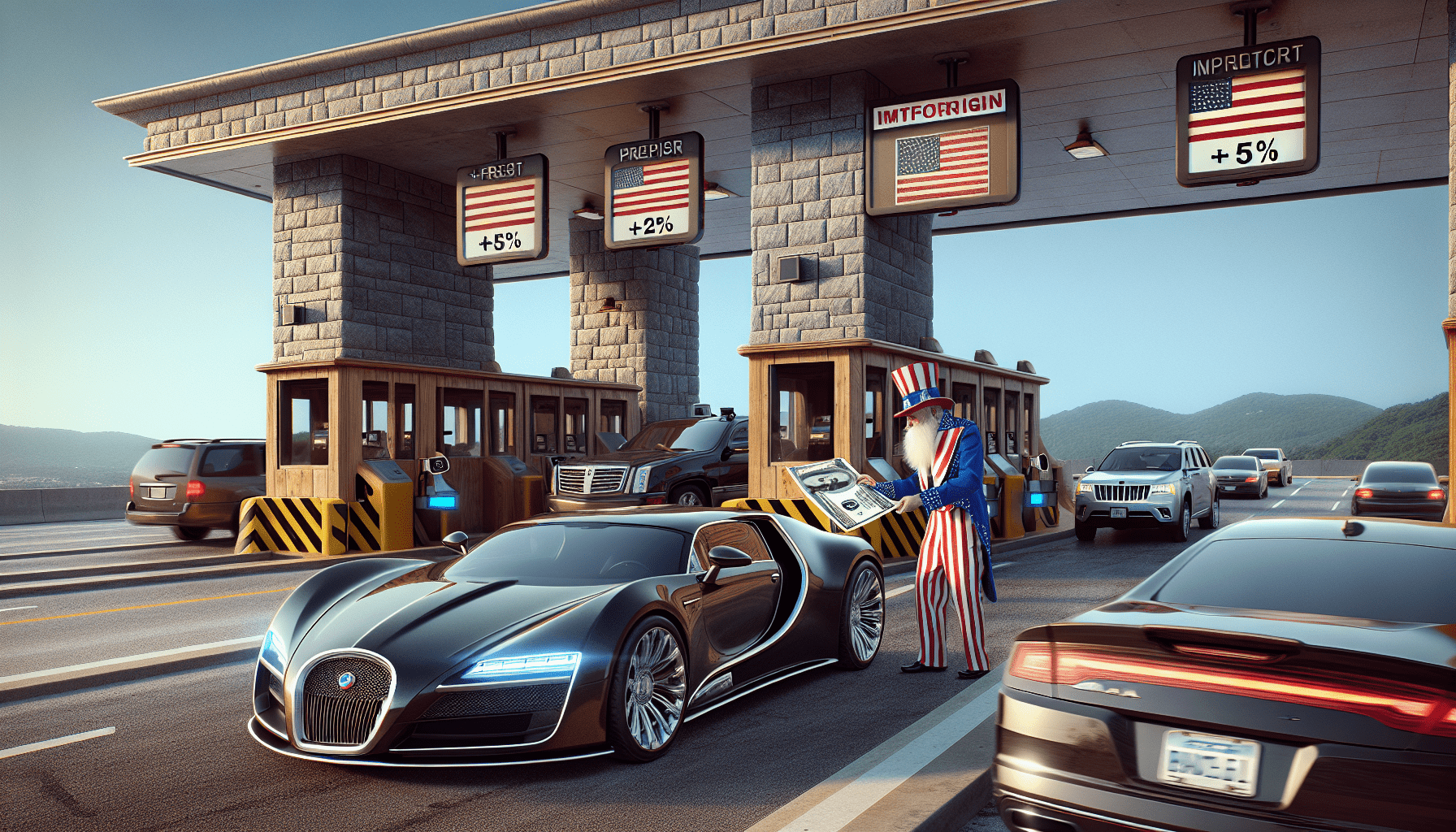Today’s the Day for Automotive Tariffs
The U.S. begins collecting 25% levies on imported cars today. Duties on imported car parts will follow soon.

Today’s the day the United States begins collecting 25% tariffs on imported cars, but the situation’s not nearly that simple. In a month, the Trump administration will extend the 25% levy to cover car parts shipped here from abroad and used in cars assembled here. Exemptions will apply only to Mexico and Canada for parts “wholly obtained, produced entirely or substantially transformed in the United States.”
The Trump administration’s goal with the tariffs is to bring automotive manufacturing back to the U.S., but the whole affair is fraught with confusion. The problems begin with an inconvenient truth most Americans are just now discovering: Manufacturing, marketing and distributing cars has become a truly international collaboration. Nearly half of all the vehicles sold in America are assembled elsewhere. And when a car is built domestically, most of its 30,000 or so parts may have come from abroad.
The nameplates affixed to cars and light trucks only add to the confusion. What appears foreign may have been homegrown, and what appears domestic have come from abroad. Let’s look at a few of the many examples.
What’s foreign and what’s domestic?
Nothing could seem more American than driving a Ford, but today’s Mustang Mach-E electric vehicles are assembled in Cuautitlán Izcalli, Mexico. Supposedly “American” cars have been produced in other countries for quite a while now. Those aging Ford Crown Victorias and Mercury Grand Marquis that still serve as police cars, taxis and family-oriented transportation were produced from 1992 to 2011 in Southwold, Ontario, Canada.
In fact, the auto industries of the U.S., Mexico and Canada are so intertwined the federal government doesn’t always separate them for statistical purposes. It’s just too complicated to sort out because parts, assemblies and finished vehicles can cross back and forth across borders multiple times during the manufacturing process. Plus, it’s been going on for a century.
Meanwhile, ostensibly exotic cars, trucks and SUVs can first see the light of day much closer to home than some might expect. That seemingly exotic BMW X7, for example, might inspire daydreams of cruising Germany’s Autobahn at 150 km/h, but it rolled off an assembly line in Spartanburg, South Carolina.
The Beemer’s far from alone. The “Japanese” perfection of the vaunted Honda Accord, the sedan that moves an American family around reliably, economically and stylishly, is created these days in Greensburg, Indiana, and 70% of the parts were fabricated in the United States.
Making “foreign” cars in the United States isn’t something new. Honda became the first Japanese company to make cars here 43 years ago when Accords began rolling out of its plant in Marysville, Ohio. Thirty-seven years ago, Honda began exporting Accord coupes from the U.S. to Japan. It was 34 years ago that the Accord station wagon became the first Honda designed, developed and built here.
But Honda wasn’t the first car maker from abroad to produce vehicles here. Volkswagen began churning out Rabbits, the successor to the Beetle, 47 years ago in a Pennsylvania factory.
Despite the resulting murkiness regarding who makes what and where, we’ll try to parse the balance of trade between the U.S. and the rest of the world when it comes to automobiles. Figures Statista gleaned from United States International Trade Commission reports can serve as a starting point.
Who sends cars to the U.S.?
Mexico, the leading automotive exporter to the United States, sent us passenger vehicles and light trucks last year valued at $75.8 billion, far more than any other country. Japan came in second at $39.7 billion, but South Korea is nipping at Nippon’s heels, placing third with $36.6 billion. Canada’s not far back in fourth place at $31.2 billion.
But what about all those Mercedes, BMWs and Volkswagens clogging America’s streets and highways? Germany takes fifth place at $24.8 billion.
From there, imports drop off quite a bit to the United Kingdom in the fifth spot with $8.2 billion. Some of us are old enough to remember when the United States was overrun with post-war British sports cars from MG, Triumph, Jaguar and Austin-Healy. Today, eight in 10 cars made in the UK are built for export, and 80% of those automotive exports are shipped to the U.S. That means the tariffs will be especially burdensome there.
Some may be surprised to find Slovakia takes sixth place among countries exporting vehicles to the U.S. with $6.3 billion. Cars with familiar nameplates like Jaguar, Land Rover and Volkswagen are made there and find their way to the U.S. It will be the European country hit hardest by the tariffs because Car exports to the U.S. represent 2.5 % of Slovakia’s GDP—more than eight times the EU average of 0.3%.
Sweden came in eighth last year among foreign car exporters to the U.S. with vehicles valued at $3.9 billion. Volvos are still arriving here, but Saabs are still in production but are no longer shipped to America.
So, those are the top automotive exporters to the U.S. Now, the question becomes what vehicles America is shipping abroad.
U.S. automotive exports
What American brands come to mind when you think about American cars? It might be Ford, Chevy and Dodge. Maybe you’d recall Buick, Cadillac, GMC, Lincoln, Jeep and Chrysler. But the leading exporters of cars built in the U.S. don’t all come from that list. Instead, when measured by the number of vehicles exported, they’re Toyota, Ford and Mercedes-Benz, according to North Atlantic Logistics. By total value, BMW leads in American-built cars exported to other countries.
Canada imports more U.S.-made cars and light trucks than any other country, say Statista researchers. In 2024, the value of those vehicles came to about $23.2 billion dollars.
In 2023, the top exporters of cars were Germany ($174 billon), Japan ($119 billion), China ($74.5 billion), the United States ($65.3 billion) and South Korea ($64.8 billion). That same year, the U.S. ranked as the No. 1 importer of cars, bringing in vehicles worth $208 billion for an automotive trade deficit of $142.7 billion.
That’s quite a gap but the Trump administration aims to close it by imposing tariffs. The tariffs will raise the price of imported cars but will also boost the prices of domestically produced cars because the manufacturers will be paying tariffs on the imported parts they use.
Some estimates place the price hike for cars sold in America at an average of $5,000 to $10,000. The increase is producing a range of reactions.
How do Americans feel about automotive tariffs?
“If you make your car in the United States, you’re going to make a lot of money,” Trump told NBC News in an interview Saturday. “If you don’t, you’re going to have to probably come to the United States because if you make your car in the United States, there is no tariff.”
Wedbush Securities analyst Dan Ives maintains the tariffs simply won’t work that way. “U.S.-made cars with all U.S. parts is a fictional tale,” he told NBC. The percentage of parts in U.S.-assembled vehicles that are sourced abroad hovers around 40%, he said.
For the United Auto Workers, the tariffs mark “the beginning of the end of a thirty-plus year ‘free trade’ disaster,” said UAW President Shawn Fain “This is a long-overdue shift away from a harmful economic framework that has devastated the working class and driven a race to the bottom across borders in the auto industry. It signals a return to policies that prioritize the workers who build this country—rather than the greed of ruthless corporations.”
The tariffs hand the keys to the car industry over to China, according to an Economic Times headline, by ruining the few parts of the EV chain that aren’t already dominated by Beijing. At the same time, South Korea and Japan, two countries investing heavily in the U.S. auto scene, will be hurt, the story noted. “If you’re wanting to bring manufacturing jobs back to the heartlands of America, landing a blow against these two Asian allies is a strange way to go about it,” the story said.
Eric Boehm, writing for libertarian-leaning Reason magazine, maintained the tariffs are on tax on the American people that no one wants. “The only winner is likely to be the federal government’s tax coffers,” he wrote. “The White House projects that the tariffs will generate $100 billion in new revenue for the government—money that Americans will pay for the privilege of buying a car the government dislikes for arbitrary reasons.”
The New Republic, a left-leaning magazine, had this to say: “I’m starting to believe April 2 really will be Liberation Day. But instead of liberating us from foreign imports, it will liberate us from any lingering illusion that Trump’s tariffs are about anything more than eliminating the progressive income tax.”
Ed McKinley is Luckbox editor-in-chief.



















